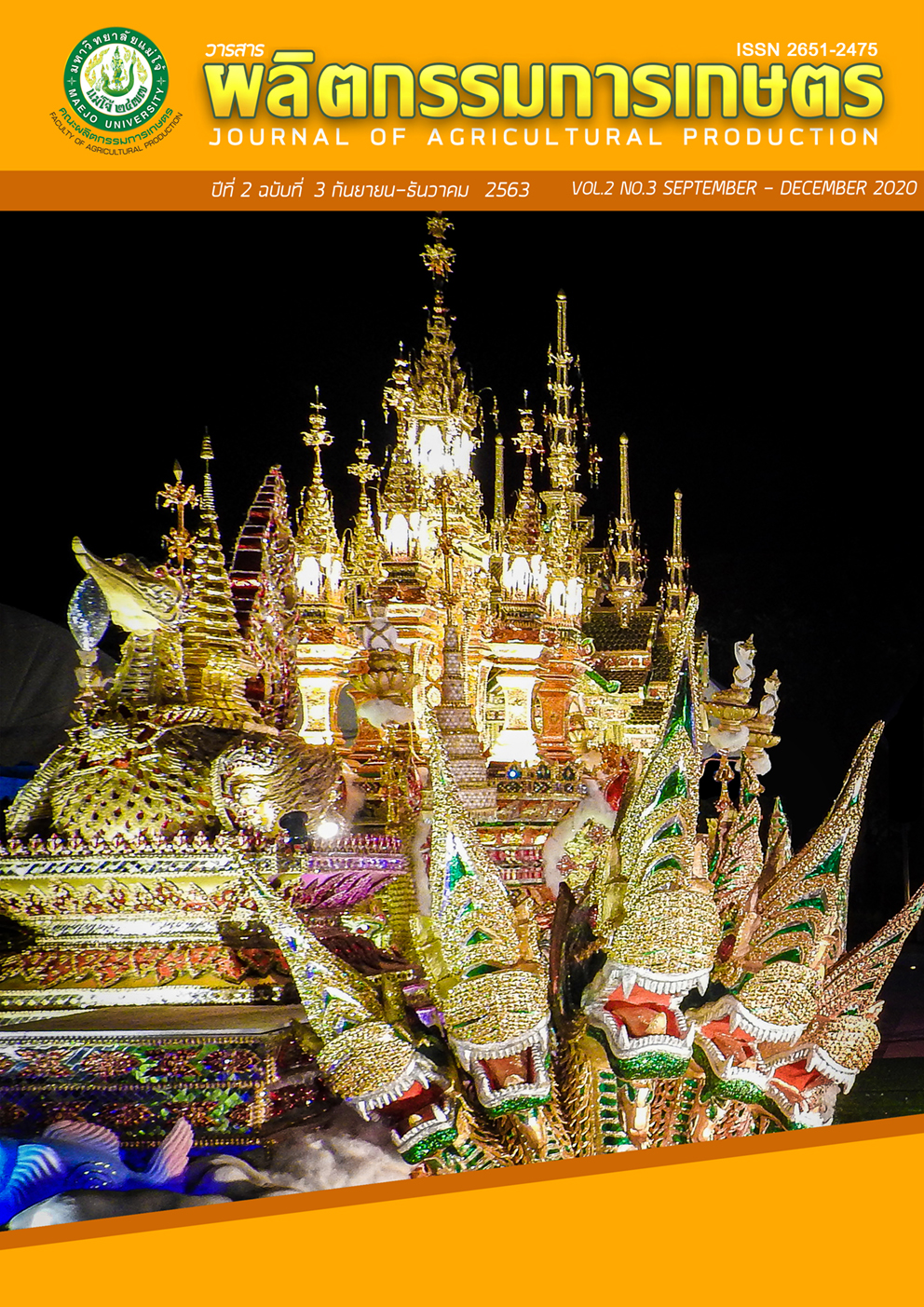พิษของสารสกัดหยาบผักคราดหัวแหวนต่อการควบคุม เพลี้ยกระโดดสีนํ้าตาลระยะตัวอ่อน
Main Article Content
บทคัดย่อ
เพลี้ยกระโดดสีนํ้าตาลเป็นแมลงศัตรูที่สำคัญ ทำให้ผลผลิตของข้าวลดลงอย่างมาก วิธีการหนึ่ง ในการควบคุมป้องกันกำจัดคือการใช้สารสกัดจากพืชสมุนไพร ดังนั้นการวิจัยนี้จึงมีจุดมุ่งหมายเพื่อทดสอบ พิษของสารสกัดหยาบจากผักคราดหัวแหวนที่สกัดด้วยเฮกเซนและเมทานอลด้วยวิธีซอล์กเลตที่มีผลต่อ ตัวอ่อนเพลี้ยกระโดดสีนํ้าตาล โดยทดสอบความเป็นพิษต่อการตายของเพลี้ยกระโดดสีนํ้าตาลระยะ ตัวอ่อน ที่ระดับความเข้มข้น 0 1,250 2,500 5,000 และ 10,000 มิลลิกรัม/ลิตร บันทึกอัตราการตายที่ เวลา 12 24 36 และ 48 ชั่วโมง คำนวณค่าความเป็นพิษ (LC50) ด้วยวิธี Probit พบว่า สารสกัดจาก ผักคราดหัวแหวนที่สกัดด้วยเฮกเซน มีค่า LC50 ต่อเพลี้ยกระโดดสีนํ้าตาลเท่ากับ 17,548.70 5,937.99 4,191.06 และ 2,792.34 มิลลิกรัม/ลิตร ที่เวลา 12 24 36 และ 48 ชั่วโมง ตามลำดับ ขณะที่สารสกัด จากผักคราดหัวแหวนที่สกัดด้วยเมทานอล มีค่า LC50 ต่อเพลี้ยกระโดดสีนํ้าตาลที่ 13,594.35 3,418.03 2,015.15 และ 1,270.18 มิลลิกรัม/ลิตร ตามลำดับ พบว่าอัตราการตายของเพลี้ยกระโดดสีนํ้าตาล ต่อสารสกัดด้วยเมทานอลที่ 10,000 มิลลิกรัม/ลิตร มีค่าสูงถึง 100 เปอร์เซ็นต์ ภายหลังการทดสอบที่ 48 ชั่วโมง อย่างไรก็ตาม สารสกัดที่สกัดด้วยตัวทำละลายทั้งสองชนิดให้ผลการตายของเพลี้ยกระโดด สีน้ำตาลที่ไม่แตกต่างกันในทุก ๆ ชั่วโมงของการทดสอบ (p ≥ 0.05) จากผลการศึกษาในครั้งนี้มีแนวโน้ม ที่ดีที่จะนำไปประยุกต์ใช้ในการป้องกันและกำจัดเพลี้ยกระโดดสีนํ้าตาลในระบบการปลูกข้าวต่อไป
Article Details

อนุญาตภายใต้เงื่อนไข Creative Commons Attribution-NonCommercial-NoDerivatives 4.0 International License.
เอกสารอ้างอิง
ก่องกานดา ชยามฤต และลีนา ผู้พัฒนพงศ์. 2545. สมุนไพรไทย ตอนที่ 7. ส่วนพฤกษศาสตร์ป่าไม้ สำนักวิชาการป่าไม้ หอพรรณไม้ กรมป่าไม้, กรุงเทพฯ.
ปรีชา วังศิลาบัตร. 2545. นิเวศวิทยาของเพลี้ยกระโดดสีนํ้าตาลและการควบคุมปริมาณ. โรงพิมพ์ชุมนุม สหกรณ์การเกษตรแห่งประเทศไทย, กรุงเทพฯ.
ภัทราภรณ์ เพ็ญโพธิ์ ชญานิศ โตมอญ กีรติ ตันเรือน ทิวธวัฒ นาพิรุณ วิษณุ ธงชัย ยุทธศักดิ์ แช่มมุ่ม และพิสิษฐ์ พูลประเสริฐ. 2562. การประยุกต์ใช้สารสกัดหยาบจากสาบเสือในการควบคุมเพลี้ยกระโดดสีนํ้าตาล. วารสารเกษตรนเรศวร. 16 (2) : 45-58.
วารี หงส์พฤกษ์. 2543. เพลี้ยจักจั่นและเพลี้ยกระโดดศัตรูพืชเศรษฐกิจในประเทศไทย. กองกีฏและสัตววิทยา กรมวิชาการเกษตร.
สุวัฒน์ บุญจันทร์. 2550. รายงานการวิจัยเรื่องการใช้สารสกัดจากผักคราด (Spilanthes acmella (Linn.) Murr.) ในการป้องกันกำจัดเพลี้ยกระโดดสีนํ้าตาลและแมลงศัตรูข้าวที่สำคัญ. มหาวิทยาลัยขอนแก่น.
Abbott, W.S. 1925. A Method of Computing the Effectiveness of an Insecticide. Journal of Economic Entomology 18:265-267.
Barbosa, A.F., M.G. Carvalho and R.E. Smith. 2016. Sabaa-Srur, Spilanthol: occurrence, extraction, chemistry and biological activities. Revista Brasileira de Farmacognosia 26(1): 128-133.
Erickson, A.J., M.G. Nair and R.S. Ramsewark. 1999. Bioactive N-isobutylamides frome the flower buds of Spilenthes acmella. Phytochemistry 51: 729-732.
Finney, D.J. 1971. Probit Analysis. 3rd Edition, Cambridge University Press. Cambridge.
Khoa, D. B., B. X. Thang, N. V. Liem, N. Holst and M. Kristensen. 2018. Variation in susceptibility of eight insecticides in the brown planthopper Nilaparvta lugens in three regions of Vietnam 2015-2017. PLOS ONE, 13(10), e0204962.
Kumar, M.S., D. Rana, B.J. Rani and S. Agale. 2017a. Repellency effects of four Ocimum spp leaves and oils against brown planthopper, Nilaparvata lugens (stal.). Journal of Entomology and Zoology Studies 5(6): 1812-1816.
Kumar, M.S., D. Rana, B.J. Rani and S. Agal. 2017b. Insecticidal activity of different Ocimum L. spp extracts against brown planthopper, Nilaparvata lugens, (Stal.) (Delphacidae: Homoptera). Journal of Entomology and Zoology Studies 5(6): 2343-2348.
Lalthanpuii, P.B. and K. Lalchhandama. 2020. Chemical composition and broad-spectrum anthelmintic activity of a cultivar of toothache plant, Acmella oleracea, from Mizoram, India, Pharmaceutical Biology 58(1): 393-399.
Manikandan, N., J.S. Kennedy and V. Geethalakshmi. 2015. Effect of temperature on life history parameters of brown planthopper (Nilaparvata lugens Stal). African Journal of Agricultural Research 10(38): 3678-3685.
Nanthakumar, M., V.J. Lakshmi, V.S. Bhushan, S.M. Balachandran and M. Mohan. 2012. Decrease of rice plant resistance and induction of hormesis and carboxylesterasetitre in brown planthopper, Nilaparvata lugens (Stål) byxenobiotics. Pesticide Biochemistry and Physiology 102: 146–152.
Saraf, D.K. and V.K. Dixit. 2002. Spilenthes acmella Murr. Study on Its Extract Spilanthol as Larvicidal. Asian Journal of Experimental Science 16 (1&2): 9-19.
Seal, T., K. Chaudhuri and B. Pillai. 2013. Traditionally Used by the Local People of Meghalaya State in India. Asian Journal of Plant Sciences 12(4): 171-175.
Uthpala, T.G.G. and S.B. Navaratne. 2020. Acmella oleracea Plant; Identification, Applications and Use as an Emerging Food Source – Review. Food Reviews International. 1-16.


